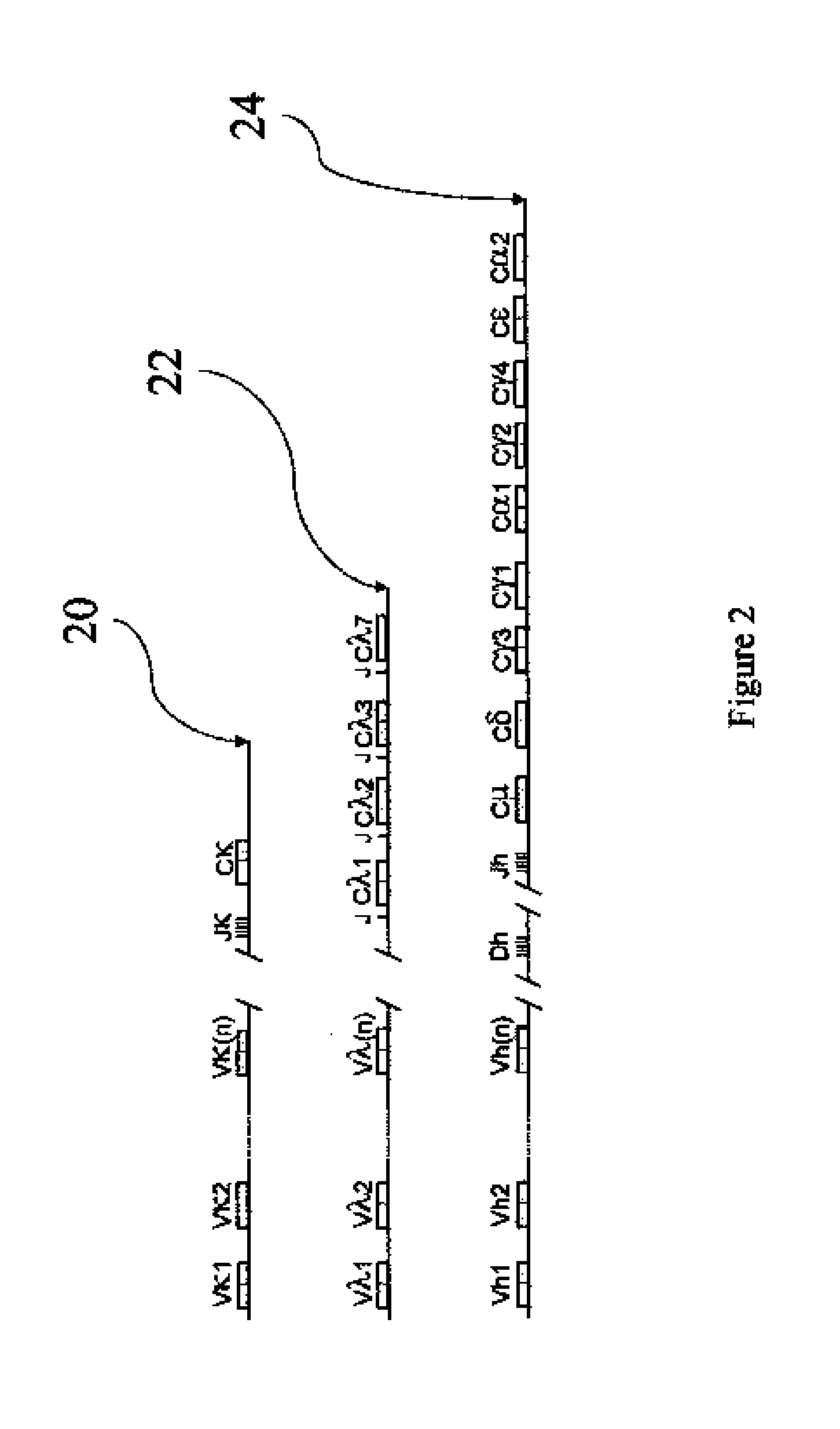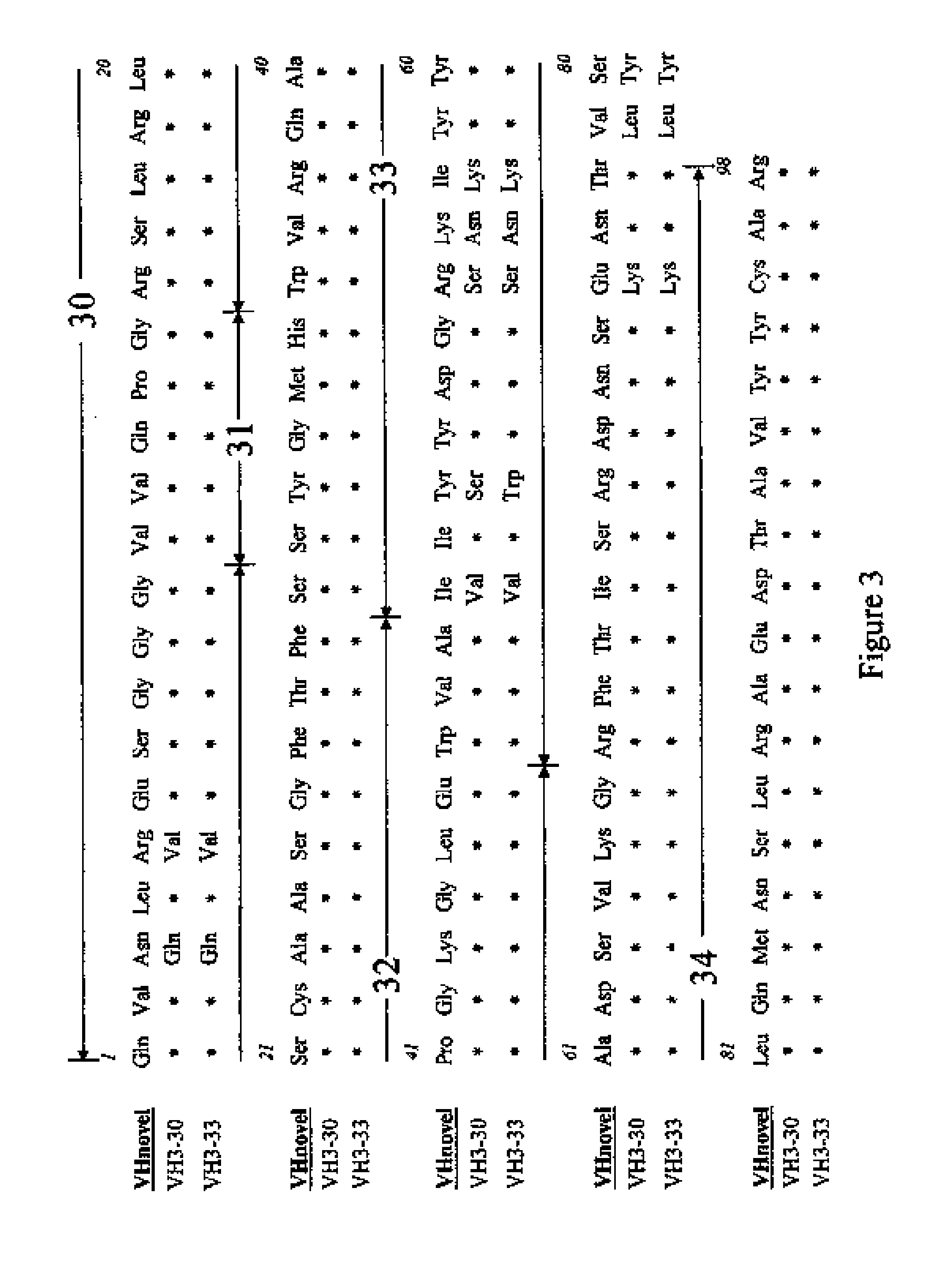Novel antibody structures derived from human germline sequences
a human germline sequence and antibody technology, applied in the field of new human germline sequence primary structure, can solve the problems of limited clinical application value of mouse monoclonal antibodies, residual murine sequences and adverse effects, and limited genetic space inherent in experimental mice, and achieve the goal of encompassing all human immunoglobulin germline genes
- Summary
- Abstract
- Description
- Claims
- Application Information
AI Technical Summary
Benefits of technology
Problems solved by technology
Method used
Image
Examples
example 1
Generation of Anti-CD152 Human Antibodies
[0025]Buffy coats from healthy blood donors, screened negative for HIV-1 / 2, HTLV-1 / 11, HCV, HBsAg and containing normal levels of alanine transferase (ALT), were obtained from the Hualien Blood Center, Chinese Blood Services Foundation (Hualien, Taiwan). Peripheral blood mononuclear cells (PBMC) were isolated by density centrifugation (400×g) on Ficoll-Paque (GE Healthcare, Uppsala, Sweden).
[0026]The obtained PBMC were first magnetically labeled with CD45RO MACS microbeads (Miltenyi Biotec, Auburn, Calif.) then separated by using a VarioMACS (Miltenyi Biotec) instrument. The eluted CD45RO′ cells were recovered by 100×g centrifugation and were used immediately in culture at a density of 2×106 cells / ml in RPMI-1640 (HyQ™; HyClone, Logan, Utah) supplemented with 1× non-essential amino acids (Life Technologies, Grand Island, N.Y.), 10% human scrum, 50 μg / ml gentamycin / kanamycin (China Chemical & Pharmaceutical, Taipei, Taiwan), 50 μM 2-mercaptoet...
example 2
ELISA Profiling of Anti-CD152 Human Antibodies
[0029]ELISA was performed by first coating 1 μg / ml BHK cell-expressed recombinant human CD152 (CTLA-4)-mulg fusion protein (Ancell Corporation, Bayport, Minn.), 1 μg / ml monoclonal murine IgG2a (Ancell), 10 μg / well of bovine scrum albumin (BSA; Sigma) or tetanus toxoid (IT, ADImmune Corporation, Taichung, Taiwan) onto microtitre plates overnight at room temperature. Culture supernatants were diluted to the desired level in 10 mM sodium phosphate buffer, pH 8.0, containing 0 5 M sodium chloride and 0.1% Tween-20. Coated plates were incubated with diluted culture supernatants, washed, incubated with peroxidase-labeled goat antibodies against human IgG (Zymed Laboratories, So. San Francisco, Calif.) and developed (15 min) by addition of 100 μl of the chromogenic substrate o-phenylaenediamine (OPD) (Sigma). The reaction was stopped after 30 min by adding 1 M sulphuric acid, and the absorbances were read at 490 nm. EBV-infected lymphoblastoid ...
example 3
Novel Structures Identification
[0030]The novel antibody primary structures were deduced by cDNA sequencing from cloned anti-CD152-specific cells. Briefly, poly(A)+ RNA was isolated from 2×104 cells by using Dynabeads® mRNA DIRECT™ Micro Kit (Dynal Biotech, Oslo, Norway). Purified mRNA was then employed as the reaction template in reverse transcription polymerase chain reactions (RT-PCR). The RT-PCR was carried out with Titan One Tube RT-PCR System (Roche Diagnostics Corporation, Indianapolis, Ind.). PCR primer sets (1 μM) used to amplify human VH and VL were HuVH-JH (SEQ ID NO: 3 and 4) and HuVλ (SEQ ID NO: 5 and 6), respectively. The 37 temperature cycles include: one 2-min denature cycle of 94° C.; 35 cycles of 3-min denaturation at 94° C., 30-sec annealing at 51° C. and 1-min extension at 68° C.; and a final 10-min extension cycle of 68° C. Single banded PCR fragments confirmed by agarose gel electrophoresis were subjected to nucleotide sequencing. Sequences were verified (Molecu...
PUM
| Property | Measurement | Unit |
|---|---|---|
| pH | aaaaa | aaaaa |
| temperature | aaaaa | aaaaa |
| acid | aaaaa | aaaaa |
Abstract
Description
Claims
Application Information
 Login to View More
Login to View More - R&D
- Intellectual Property
- Life Sciences
- Materials
- Tech Scout
- Unparalleled Data Quality
- Higher Quality Content
- 60% Fewer Hallucinations
Browse by: Latest US Patents, China's latest patents, Technical Efficacy Thesaurus, Application Domain, Technology Topic, Popular Technical Reports.
© 2025 PatSnap. All rights reserved.Legal|Privacy policy|Modern Slavery Act Transparency Statement|Sitemap|About US| Contact US: help@patsnap.com



